#zhejiangopterus
Text

Day 8: Zhejiangopterus linhaiensis
#paleoart#art#dinosaur#prehistoric#paleontology#digitalart#traditionalart#Archovember2023#Archovember#Dinovember#Dinovember2023#DrawDinovember#DrawDinovember2023#Zhejiangopterus#Zhejiangopteruslinhaiensis#Quetzalcoatlinae#Azhdarchidae#Pterosauria#Pterosaur
78 notes
·
View notes
Text

#Archovember Day 8 - Zhejiangopterus linhaiensis
Azhdarchids are known as the largest flying animals of all time, the last great stand of the pterosaurs before . They contained mighty giants like Quetzalcoatlus and Hatzegopteryx, who ruled the skies of the Late Cretaceous. But not all azhdarchids were flying carnivorous giraffes. Some of them were downright tiny, while others reached a more modest, respectable size. Slightly larger than a female Pteranodon, Zhejiangopterus linhaiensis was one such “moderately large” azhdarchid.
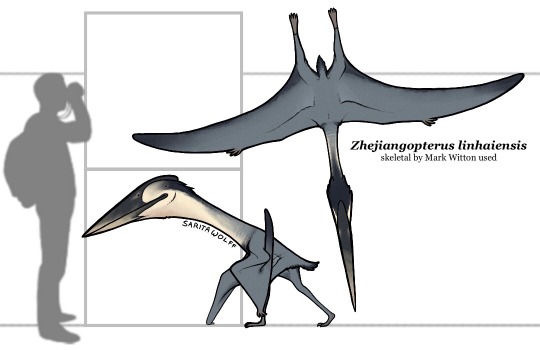
Zhejiangopterus lived in Late Cretaceous China and is so far the most complete azhdarchid known, making it very influential to our understanding of this amazing family of pterosaurs. As several specimens have been uncovered, it was probably fairly common in the Tangshang Formation. It lacked the bony crest seen in many of their relatives, instead opting for a long, straight, graceful profile. Like other azhdarchids, Zhejiangopterus were likely terrestrial stalkers similar to storks and ground hornbills, only using their wings to escape predators or move to new hunting grounds.
Not many other animals have been found in the Tangshang Formation. Alongside Zhejiangopterus, there is only the avialan Yandangornis (whose eggs and chicks and perhaps even adults, if they could catch them, could have been prey for the pterosaur) and an unnamed therizinosauroid. However, living in Late Cretaceous China, it could have also come across the titanosaur Dongyangosaurus further South, and further inland: the ankylosaur Gobisaurus, the pachycephalosaurid Sinocephale, the ornithomimid Sinornithomimus, the carcharodontosaurid Shaochilong, and the mysterious theropod Chilantaisaurus. No doubt there were also plenty of lizards, snakes, mammals, amphibians, and small dinosaurs hiding in the coastal grasses, ready to be nabbed by the dragon of Zhejiang.
#my art#SaritaDrawsPalaeo#Zhejiangopterus#Zhejiangopterus linhaiensis#azhdarchids#pterodactyloids#pterosaurs#archosaurs#archosauromorphs#reptiles#Archovember#Archovember2023
55 notes
·
View notes
Text
#Sagan 4#birgworld#Iguanodont#AESL#sina-man#amphiterra#Citysaurus#hamsters paradise#tribbetherium#runaway to the stars#jayrockin#on beyond Holocene#zhejiangopterus#Batterymaster01#athrymagaia#spec evo#speculative evolution#shout out to all the spec creators of tumblr and beyond
56 notes
·
View notes
Text

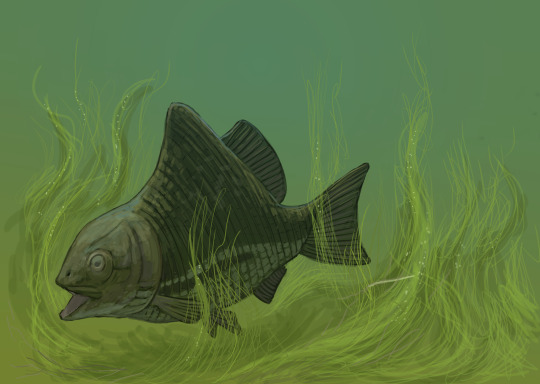

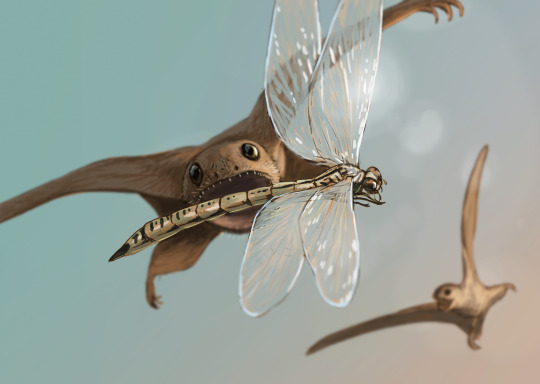
Results from the #paleostream
Polysentor, Luoxiongichthys, Zhejiangopterus, Isophlebia.
#paleoart#sciart#fish#chimera#pterosaur#dragonfly#azhdarchid#solnhofen#mist#underwater#animal#sketch#paleostream#palaeoblr
570 notes
·
View notes
Note
I'm not too familiar with pterosaur anatomy but are their heads supposed to be so weirdly big?
Yep! That's entirely based on skeletal data, pterosaurs, especially pteranodontids and azhdarchids, had huge skulls. However, the skulls were lightened by large holes and air pockets, so there's not actually that much bone even for such a big head!

Here's the skeleton of Zhejiangopterus from Witton & Naish (2008). Notice the gigantic air hole in the middle of the skull! It would have been covered in fleshy nasal tissue, but it's a crucial weight-saving feature.
314 notes
·
View notes
Text
I drew a Zhejiangopterus linhaiensis and here are two versions of my Zhejiangopterus.
DO NOT REPOST OR USE my art.
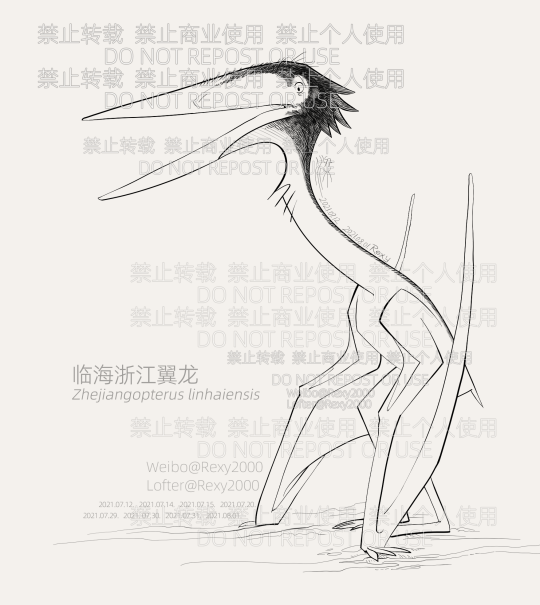
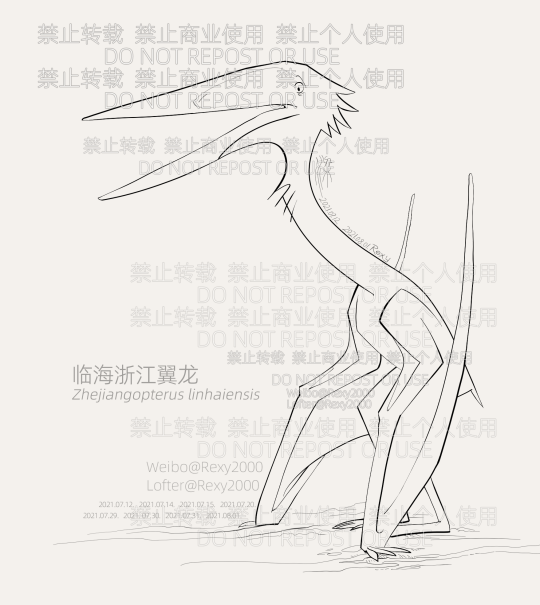
It took me 8 days to work on the Zhejiangopterus. Reconstructing the creature was not easy for me. Honestly something is wrong with the Zhejiangopterus's chest and shoulders, and I didn't really draw the coracoids😂. But anyway, it was good to try to draw a new species and learn something about Zhejiangopterus. I will draw the species again in the future.
I have a more detailed post on Lofter:
Liang Rexy嘅第1篇���章。
于2021年9月9日发布。
#无厘头羽王龙#Zhejiangopterus#Zhejiangopterus linhaiensis#prehistoric animal#Pterosaur#无厘头羽王龙嘅作品#Liang Rexy's works
27 notes
·
View notes
Text



6 notes
·
View notes
Text

Contemplation
Zhejiangopterus
2 notes
·
View notes
Photo

Well heck. After posting almost every day in January, I then posted exactly one day in February. See, this is why at the beginning of the year I tried to make a commitment to post every day, because I knew that once I missed a day or two it would be easy to justify missing many more. Well, okay, no, I can’t say that I really went through that though process on a conscious level, but maybe I had that motivation subconsciously.
Regardless, I am going to try to post every day in March, so to that end, enjoy these very rough concept sketches for the character designs for another project I’m working on. (”Working on” in the sense that, um, I’m trying to create it, not “working on” in the sense that anyone is paying me to do it. (Yet?))
#character design#sketch#concept sketch#The Very High Seas#velociraptor#azhdarchid#zhejiangopterus#Vendia#vendobiont#pirate#pirates#opabinia#diplocaulis#Captain Vane#Rapton Vane#Dima Nicorena#Dima#Jiang Lin#Reggie O'Nye#Eddie Corcoran#Lin#Reggie#Eddie#Rapton
2 notes
·
View notes
Text
Zhejiangopterus linhaiensis

By Chris Masnaghetti; retrieved from http://www.pteros.com/, a website dedicated to education about Pterosaurs.
A reminder that we will not be able to do every pterosaur until we reach $240 in donations on our patreon, so please donate even a dollar if you can.
Name: Zhejiangopterus linhaiensis
First Described: 1994
Described By: Cai & Feng
Classification: Avemetatarsalia, Ornithodira, Pterosauromorpha, Pterosauria, Macronychoptera, Novialoidea, Breviquartossa, Pterodactylomorpha, Monofenestrata, Pterodactyliformes, Caelidracones, Pterodactyloidea, Eupterodactyloidea, Ornithocheiroidea, Azhdarchoidea, Neoazhdarchia, Neopterodactyloidea, Azhdarchidae
Zhejiangopterus is our next Azhdarchid. It’s a pretty standard Azhdarchid, but it’s this way because it pretty much told us what a standard Azhdarchid is. Its bones were first discovered in 1986, and described in 1994. At least seven individuals have been recovered, ranging from partial skulls to near-complete skeletons, revealing for the first time in the literature the full bauplan of Azhdarchids. It has a large crestless head with a huge nasoantorbital fenestra, a very long neck, and long limbs. It lived in Late Cretaceous China (the 81.5-million-year-old Tangshang Formation, specifically). At a 3.5 meter wingspan, it was a moderately-sized terrestrial stalker.
Sources:
Cai, Z., Wei, F. 1994. Zhejiangopterus linhaiensis (Pterosauria) from the Upper Cretaceous of Linhai, Zhejiang, China. Vertebrata PalAsiatica, 32:3, 181-194.
https://www.pteros.com/pterosaurs/zhejiangopterus.html
#zhejiangopterus#zhejiangopterus linhaiensis#pterosaur#azhdarchid#pterosaur ptuesday#palaeoblr#azhdarchoid#paleontology#prehistory#prehistoric life#biology#science#nature#factfile
55 notes
·
View notes
Text
Zhejiangopterus

Scientific Name: Zhejiangopterus linhaiensis
Diet: About anything it can bite. We feed them a varied diet of small rodents, fish, fruits, berries, and plant clippings
Projected Natural Lifespan: 30 years
Wingspan: 3.5 meters (11.5 feet)
Height: 1.6 meters (5.25 feet)
Weight: 7.9 kg (17 lbs)
Locality: Zhejiang, China (Tangshang Formation); 81.5 Ma
Exhibit: The Hub
About
Zhejiangopterus is a comparatively small azhdarchid from late Cretaceous China. It’s known from almost complete skeletons, being the first azhdarchid to really give a glimpse of their physiology and lifestyle. Zhejiangopterus has, like all azhdarchids, a really long neck, long limbs, and a tiny body. Its skull is long, narrow, and toothless, with a large weight-saving antorbital fenestra. As with other azhdarchids, Zhejiangopterus is a terrestrial stalker, roaming open areas grabbing small animals and other prey items from above.
At Huxley
A group of four Zhejiangopterus can be found at the Hub. Two more live behind-the-scenes, and, when they’re up for it, they make appearances in the Flight Show.
Notable Behavior
Our Zhejiangopterus are a close-knit bunch. They commonly move about in a group, picking food off the ground together. While they can fly, they don’t do so very often, preferring to stride - even gallop - on the ground. They often engage in bonding behaviors, including preening and calling to each other. During the mating season, add a ritual dance between paired partners to that list. The males (who have red heads and white necks) initiate by bowing the head, followed by reciprocal beak-nuzzling and wing-extending by both individuals. Zhejiangopterus pair each season - they do not mate for life.
They’ll eat pretty much anything - I’m amazed by how much they can fit down their gullets. Each one has different tastes, but they all love berries. We scatter small bits of food around the aviary two to three times a day. Some is obvious to their eyes, while other food is hidden in logs and feeder balls, giving a bit more of a challenge. They can (and do) use a wing to overturn objects in the exhibit looking for food, and their natural curiosity means nothing stays hidden for long.
Keeper Notes
When I say they eat everything, I do mean everything. Please, don’t litter.
51 notes
·
View notes
Text

Whelp we’ve got about a week and a half til November (aaaaaah), so I guess I’ll post this year’s Archovember list now!
It’s a bit dinosaur-heavy this time, but there are a lot of species I’d really like to try my hand at! Also, we have two leptoceratopsians and two Araripesuchus species. I thought it would be interesting to compare and contrast these species within the same month, so I hope it doesn’t get /too/ repetitive!
For new folks: this is my “Draw Dinovember” list that I expanded out to include other archosauriforms. I started doing this a few years ago to challenge myself to draw species I’ve never drawn before and/or ones that don’t get a lot of attention. Feel free to join in! You can do the whole list, just the dinosaurs, just the pterosaurs, just the pseudosuchians, just your favorites, just ones you’ve never drawn before, roll a D20 and a D10 and draw the sum of whichever numbers you get, etc. Just make sure they’re posted on or after their specific day so I remember to share them on my blog! You can use #Archovember or #Archovember2023, as those are the tags I follow. (Note that I and the whole Archovember event are usually a lot more active on Instagram so if you have an IG I encourage you to join in there!)
Anyway, here is the list in case the graphic is hard to read:
1. Your Choice!
2. Furcatoceratops elucidans
3. Tupandactylus navigans
4. Deinosuchus hatcheri
5. Herrerasaurus ischigualastensis
6. Lewisuchus admixtus
7. Supersaurus vivianae
8. Zhejiangopterus linhaiensis
9. Dynamosuchus collisensis
10. Megalosaurus bucklandii
11. Macrospondylus bollensis
12. Miragaia longicollum
13. Dorygnathus banthensis
14. Leptoceratops gracilis
15. Stagonolepis robertsoni
16. Shantungosaurus giganteus
17. Paleorhinus bransoni
18. Cascocauda rong
19. Kelenken guillermoi
20. Prestosuchus chiniquensis
21. Yangchuanosaurus shangyouensis
22. Istiodactylus latidens
23. Kunbarrasaurus ieversi
24. Araripesuchus wegeneri
25. Tylocephale gilmorei
26. Ixalerpeton polesinensis
27. Udanoceratops tschizhovi
28. Tapejara wellnhoferi
29. Araripesuchus rattoides
30. Scutellosaurus lawleri
One last note, and a warning I usually issue to new paleoartists: while looking for references for these species you’ll come across David Peters. His references tend to dominate search results when looking for less well-known species. They are also highly inaccurate, even the skeletals. So make sure you omit “The Pterosaur Heresies” and “Reptile Evolution” from your google search. If you have issues finding references, let me know and I can share what I’m using!
#my art#Archovember#Archovember2023#SaritaDrawsPalaeo#dinosaurs#pterosaurs#pseudosuchians#archosaurs#archosauriforms
56 notes
·
View notes
Photo

Tentando fazer uma pintura ahha um dia pego o jeito.. Zhejiangopterus #jurassicpark #jurrasicworld #jurrasic #zhejiangopterus #pterossaurus #draw #art #challenge #dinosaur #scketch #sketchbook #drawing #illustration #dinossauro #dino #instaart #pen #pencil #ilustra #paper #wip #fabercastell #nerd #geek #paleoart #dinosaurart #painting #painting #pintura
#pintura#drawing#jurrasicworld#paleoart#zhejiangopterus#illustration#pen#draw#dinosaurart#scketch#jurassicpark#art#nerd#paper#sketchbook#instaart#dino#ilustra#dinossauro#dinosaur#challenge#pterossaurus#geek#painting#fabercastell#pencil#jurrasic#wip
0 notes
Text
I play Jurassic World The Game so I’m gonna use this blog to keep a personal record of progress assuming I don’t get bored of it. Probably every week or something I’ll make a progress thing. Been playing since March but I’m gonna count the beginning of my record as week 1. Also there’s 100% misspellings somewhere dino names are hard...also my park is a mess so no progress on fixing that
CURRENT LEVEL: 55
CURRENT RESOURCES:
15,744 DNA
4,410,644 Food
6,714,344 Coins
4,128 Dino Bucks
33,362 VIP Points
2,647 Velociprator DNA
2,316 Monolophosaurus DNA
582 Euoplocephalus DNA
525 Sarcosuchus DNA
235 Kaprosuchus DNA
41 Dimetrodon DNA
Week 1: Current Creatures
COMMON
Triceratops [Max Level 40]
Majungasaurus [Max Level 40]
Guanlong [Max Level 40]
Tropeognathius [Max Level 40]
Alanqa [Max Level 40]
Limnocelis [Max Level 40]
Labyrinthodontia [Max Level 40]
Argentinosauris [Max Level 40]
[Hybrid] Alangasaurus [Max Level 40]
Bonitasaura [Max Level 20]
Tuojiangosaurus [Max Level 20]
Pelecanimimus [Max Level 20]
Diplocaulus [Max Level 20; used level 40 for hybrid]
Hatzegopteryx [Max Level 20]
Utahraptor [Max Level 20]
[Hybrid] Labyrinthosaurus [Max Level 20]
RARE
Dilophosaurus [Max Level 40]
Diplodocus [Max Level 40]
Nundasuchus [Max Level 40]
Tapejara [Max Level 30]
Allosaurus [Max Level 20]
Giganotosaurus [Max Level 20]
Koolasuchus [Max Level 20]
Carnotaurus [Max Level 20]
Monolophosaurus [Max Level 20]
[Hyrbid] Diplotator [Max Level 20]
Irritator [Max Level 10; used level 40 for hybrid]
Ophiacodon [Max Level 10; used level 40 for hybrid]
Nasutoceratops [Max Level 10]
Dsungaripterus [Max Level 10]
Gallimimus [Max Level 10; used level 40 for hybrid]
Pachycephalosaurus [Max Level 10]
Pyroraptor [Max Level 10]
[Hybrid] Ophiacomimus [Max Level 10]
SUPER RARE
Postosuchus [Max Level 40]
Protostega [Max Level 40]
Zhejiangopterus [Max Level 40]
Stegosaurus [Max Level 30]
Deinotherium [Max Level 30]
Rajasaurus [Max Level 20]
Elasmotherium [Max Level 20]
Amphicyon [Max Level 20]
Archaeotherium [Max Level 20]
Velociraptor [Max Level 20]
Velociraptor Gen 2 [Max Level 20]
Synthetoceras [Max Level 20]
Dakosaurus [Max Level 20]
Onchopristis [Max Level 20]
Leptocleidus [Max Level 20]
Xiphactinus [Max Level 20]
Geosaurus [Max Level 20]
Baculites [Max Level 10]
Elasmosaurus [Max Level 10]
Helicoprion [Max Level 10]
Parasaurolophus [Max Level 10]
Ankylosaurus [Max Level 10]
Quetzalcoatlus [Max Level 10]
Megistotherium [Max Level 10]
Doedicurus [Max Level 10]
Supersaurus [Max Level 10]
Spinosaurus [Max Level 10]
Kaprosuchus [Max Level 10]
Trinacromerum [Max Level 10]
Mauisaurus [Max Level 10]
Psephoderma [Max Level 10]
LEGENDARY
Unaysaurus [Max Level 20]
Pteranodon [Max Level 20]
Ermotherium [Max Level 20]
Ichthyostega [Max Level 20]
Sarcosuchus [Max Level 10]
Suchomimus [Max Level 10]
Shunosaurus [Max Level 10]
Andrewsarchus [Max Level 10]
Tyranosaurus Rex [Max Level 10]
Tyranosaurus Rex Gen 2 [Max Level 10]
Leedsichthys [Max Level 10]
Plesiosaurus [Max Level 10]
Styxosaurus [Max Level 10]
0 notes
Text
Alanqa
Alanqa
Alanqa is a genus of pterosaur from the Late Cretaceous Kem Kem Beds (which date to the late Albian or Cenomanian age) of southeastern Morocco.
The name Alanqa comes from the Arabic word العنقاء al-‘anqā’, for a Phoenix similar to the Simurgh of Persian mythology.
History and discovery
Aided by local villagers, a team of paleontologists had been excavating at several locations in the Kem Kem Beds during April, and November to December 2008, uncovering remains of several different pterosaurs. The material was fragmentary, and the type locality for Alanqa is Aferdou N'Chaft, near the village of Begaa and 10 km to the north-east of Taouz.
Description
Holotype specimen (FSAC-KK 26)
Alanqa is known only from five fragments of the front upper and lower jaws, and possibly a neck vertebra, representing the single type species Alanqa saharica. Two of these fragments were first described, but not named, by Wellnhofer and Buffetaut in 1999, and referred to a pteranodontid. Three additional jaw specimens, including a better preserved upper jaw, were described and named by Ibrahim and colleagues in 2010. The jaws were straight and pointed, like those of the azhdarchids Quetzalcoatlus and Zhejiangopterus. Based on comparison to related species, the Alanqa saharica the individuals known from jaw specimens probably had wingspans of about 4 meters (about 13 ft). However, according to Ibrahim and colleagues, the vertebra (which probably belonged to the same species) appeared to come from a larger individual, measuring about 6 meters (about 20 ft) in wingspan.
A rostrum fragment was described in 2015 and referred to cf. Alanqa based on provenance. This fragment has two bony protuberances where the jaw occludes, coinciding with an eminence on one of the mandibles originally referred to Alanqa. These imply an unusual functional specialization in this pterosaur; possible functions include visual display, anchoring of soft tissue, and crushing hard-shelled food.
source - Wikipedia
Dear friends, if you liked our post, please do not forget to share and comment like this. If you want to share your information with us, please send us your post with your name and photo at [email protected]. We will publish your post with your name and photo. thanks for joining us www.rbbox.in
from Blogger https://ift.tt/2sW4OLs
0 notes
